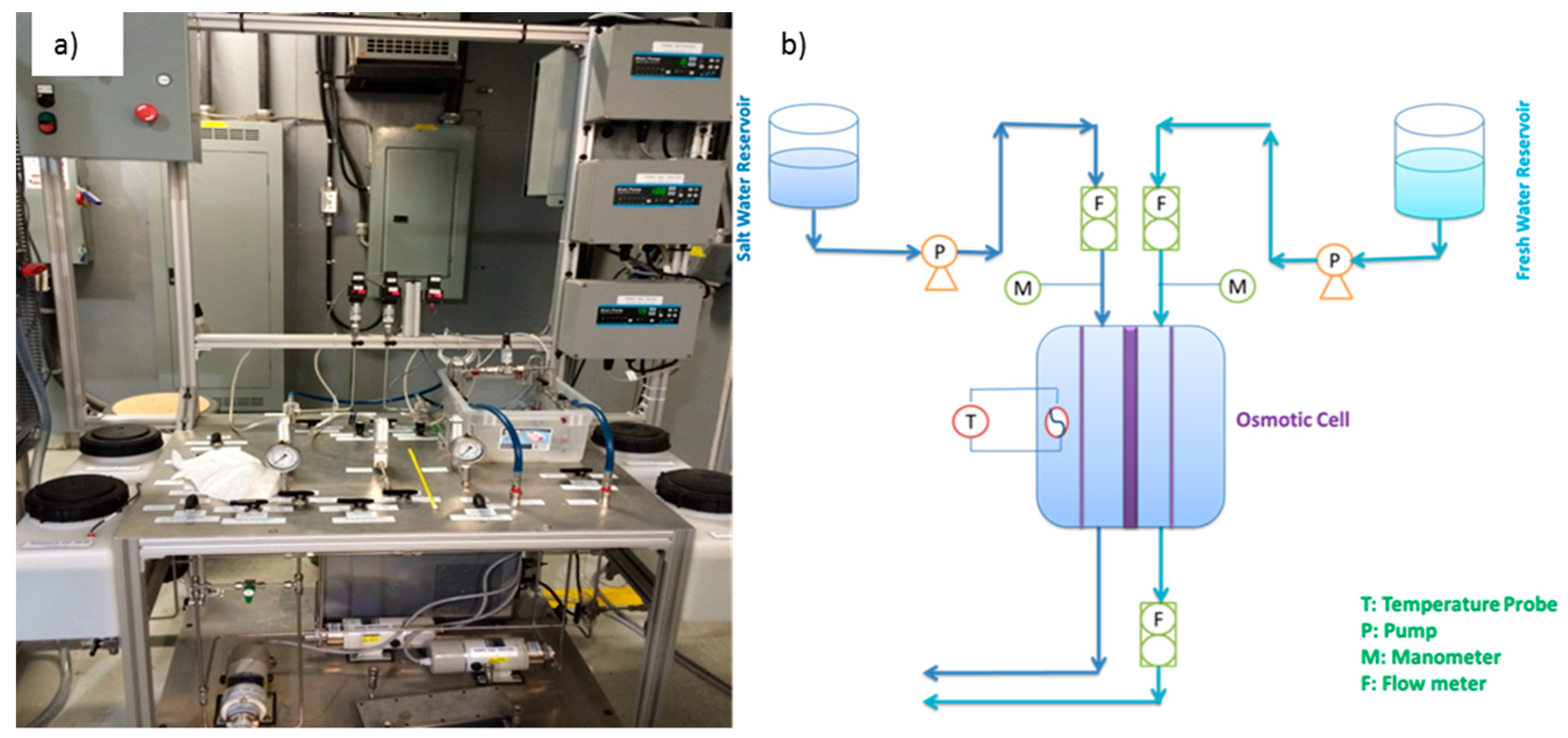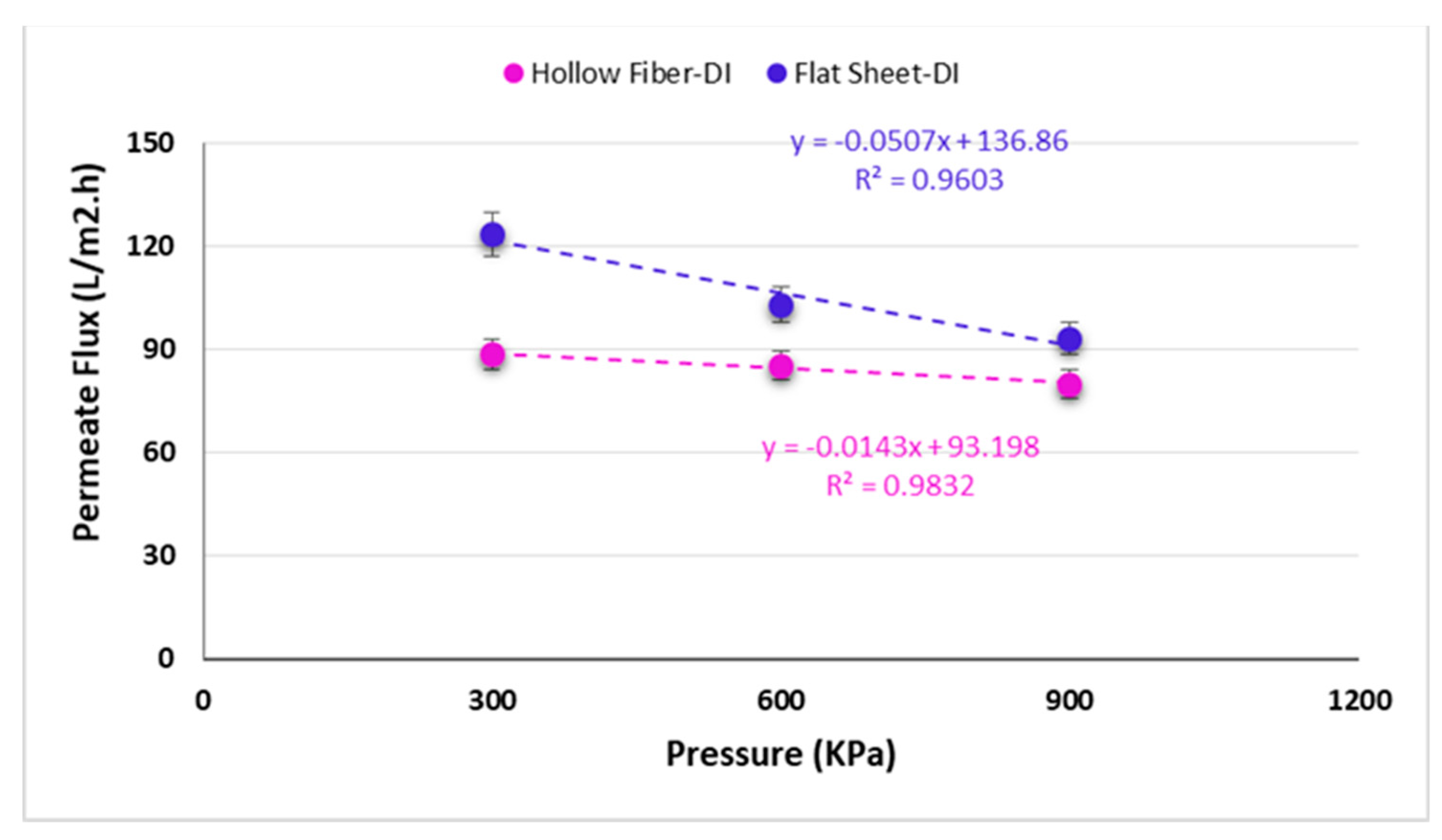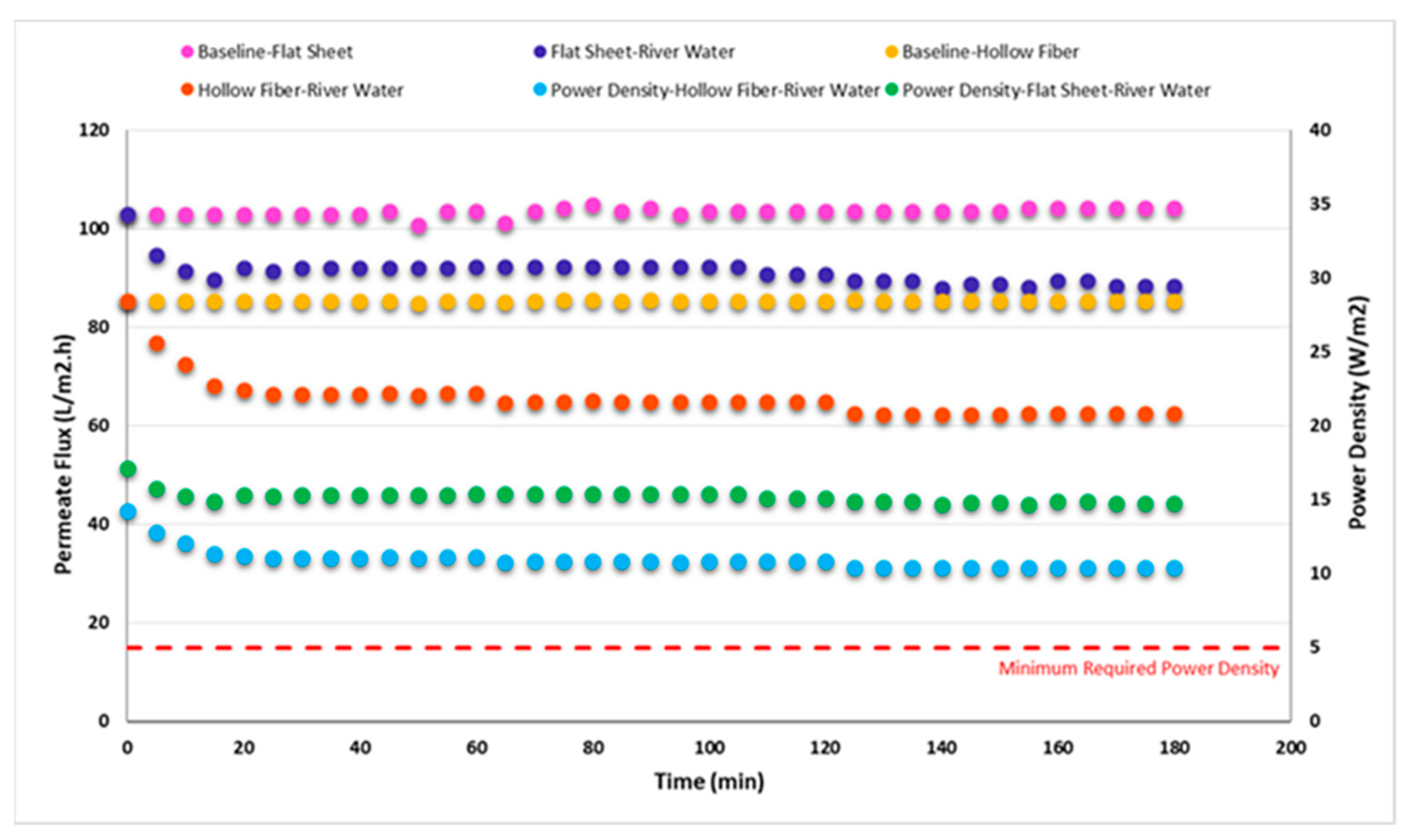Feasibility of Pressure-Retarded Osmosis for Electricity Generation at Low Temperatures
Abstract
:1. Introduction
2. Materials and Methods
2.1. Chemicals
2.2. Water Quality
2.3. PRO Unit
2.3.1. Membrane and Spacer
Flat Sheet Membrane
Hollow Fiber Membrane
2.3.2. PRO Experiments
- W: Power density (W/m2)
- : PRO membrane permeate flux ()
- : Differential hydraulic pressure across the membrane (Pa)
3. Results and Discussion
3.1. Investigation of Temperature Effect on Permeate Flux
3.2. Salt Concentration Effect on Permeate Flux at Low Temperature
3.3. Influence of Pressure on Permeate Flux and Power Density at Low Temperature
3.4. Impact of Fouling on Permeate Flux at Low Temperature
4. Conclusions
Author Contributions
Funding
Institutional Review Board Statement
Informed Consent Statement
Data Availability Statement
Acknowledgments
Conflicts of Interest
References
- Abbasi-Garravand, E. Using Pressure Retarded Osmosis Technology to Generate Salinity Gradient Energy (Osmotic Power) as a New Renewable Energy Source: Pre-Treatment to Reduce PRO Membrane Fouling; Concordia University: Montreal, QC, Canada, 2016. [Google Scholar]
- Abbasi-Garravand, E.; Mulligan, C.N.; Laflamme, C.B.; Clairet, G. Using Ultrafiltration and Sand Filters as Two Pretreatment Methods for Improvement of the Osmotic Power (Salinity Gradient Energy) Generation Process. In Proceedings of the 4th Climate Change Technology Conference, Montreal, QC, Canada, 25–27 May 2015; pp. 1–12. [Google Scholar]
- Sarp, S. Fundamentals of Pressure Retarded Osmosis-Current Trends and Future Developments on (Bio-) Membranes. In Membrane Desalination Systems: The Next Generation; Elsevier: Swansea, UK, 2019; pp. 271–283. [Google Scholar]
- Nagy, E.; Meiczinger, M.; Vitai, M. Investigation of the Improvement of Energy Generation by Pressure Retarded Osmosis. J. Membr. Sci. Res. 2019, 5, 137–146. [Google Scholar]
- Kishimoto, M.; Tanaka, Y.; Yasukawa, M.; Goda, S.; Higa, M.; Matsuyama, H. Optimization of Pressure-Retarded Osmosis with Hollow-Fiber Membrane Modules by Numerical Simulation. Ind. Eng. Chem. Res. 2019, 58, 6687–6695. [Google Scholar] [CrossRef]
- Abbasi-Garravand, E.; Mulligan, C.N.; Laflamme, C.B.; Clairet, G. Identification of the Type of Foulants and Investigation of the Cleaning Methods for PRO Processes in Osmotic Power Application. Desalination J. 2017, 421, 135–148. [Google Scholar] [CrossRef]
- Achilli, A.; Cath, T.Y.; Childress, A.E. Power generation with pressure retarded osmosis: An experimental and theoretical investigation. J. Membr. Sci. 2009, 343, 42–52. [Google Scholar] [CrossRef]
- Achilli, A.; Childress, A.E. Pressure retarded osmosis: From the vision of Sidney Loeb to the first prototype installation—Review. Desalination 2010, 261, 205–211. [Google Scholar] [CrossRef]
- Alsvik, L.I.; Hägg, M. Pressure Retarded Osmosis and Forward Osmosis Membranes: Materials and Methods. Polymers 2013, 5, 303–327. [Google Scholar] [CrossRef] [Green Version]
- Chae, S.H.; Kim, Y.M.; Park, H.; Seo, J.; Lim, S.J.; Kim, J.H. Modeling and Simulation Studies Analyzing the Pressure-Retarded Osmosis (PRO) and PRO-Hybridized Processes. Energies 2019, 12, 243. [Google Scholar] [CrossRef] [Green Version]
- Makabe, R.; Ueyama, T.; Sakai, H.; Tanioka, A. Commercial Pressure Retarded Osmosis Systems for Seawater Desalination Plants. Membranes 2021, 11, 69. [Google Scholar] [CrossRef]
- Abbasi-Garravand, E.; Mulligan, C.N.; Laflamme, C.B.; Clairet, G. Role of Two Different Pretreatment Methods in Osmotic Power (Salinity Gradient Energy) Generation. Renew. Energy 2016, 96, 98–119. [Google Scholar] [CrossRef]
- Xu, Y.; Peng, X.; Tang, C.Y.; Fu, Q.S.; Nie, S. Effect of draw solution concentration and operating conditions on forward osmosis and pressure retarded osmosis performance in a spiral wound module. J. Membr. Sci. 2010, 348, 298–309. [Google Scholar] [CrossRef]
- Thelin, R.W.; Sivertsen, E.; Holt, T.; Brekke, G. Natural organic matter fouling in pressure retarded osmosis. J. Membr. Sci. 2013, 438, 46–56. [Google Scholar] [CrossRef]
- Heo, J.; Chu, K.H.; Her, N.; Im, J.; Park, Y.; Cho, J.; Sarp, S.; Jang, A.; Jang, M.; Yoon, Y. Organic fouling and reverse solute selectivity in forward osmosis: Role of working temperature and inorganic draw solutions. Desalination 2016, 389, 162–170. [Google Scholar] [CrossRef]
- Sivertsen, E.; Holt, T.; Thelin, W.R. Concentration and Temperature Effects on Water and Salt Permeabilities in Osmosis and Implications in Pressure-Retarded Osmosis. Membranes 2018, 8, 39. [Google Scholar] [CrossRef] [Green Version]
- Anastasio, D.; Arena, J.; Cole, E.; McCutcheon, J. Impact of temperature on power density in closed-loop pressure retarded osmosis for grid storage. J. Membr. Sci. 2015, 479, 240–245. [Google Scholar] [CrossRef] [Green Version]
- Laflamme, C.B. Challenges Facing Osmotic Power in Canada; INES Meeting: Amsterdam, The Netherlands, 2013. [Google Scholar]
- Laflamme, B.C.; Bourassa-Duchesneault, Y.; Caumartin, J.; Champagne, P.; Durand, J.; Lavallee, G.; Levert, F.; Ouellette, X.; Rahni, M.; Servant, B.; et al. Énergie Osmotique–Résultats D’étape, Niveau 5, Rapport LTE-RT-2014-0035; Institut de recherche d’Hydro-Quebec: Shawinigan, QC, Canada, 2014; pp. 1–58. [Google Scholar]
- Hydro-Québec. Plan D’approvisionnement 2014–2023 des Réseaux Autonome; Hydro-Québec: Montreal, QC, Canada, 2013. [Google Scholar]
- Touati, K.; Hänel, C.; Tadeo, F.; Schiestel, T. Effect of the feed and draw solution temperatures on PRO performance: Theoretical and experimental study. Desalination 2015, 365, 182–195. [Google Scholar] [CrossRef]
- Millero, J.F.; Wing, H.L. The thermodynamics of sea water at one atmosphere. Am. J. Sci. 1976, 276, 1035–1077. [Google Scholar] [CrossRef]
- Culkin, F.; Cox, R.A. Sodium, potassium, magnesium, calcium and strontium in sea water. Deep Sea Res. 1966, 13, 789–804. [Google Scholar] [CrossRef]
- Laflamme, C.B. Énergie Osmotique-Éléments de Conception Pour les Bancs D’essais LTE; Rapport LTE-RT-2013; Institut de recherche d’Hydro-Québec: Shawinigan, QC, Canada, 2013; p. 31. [Google Scholar]
- Abbasi-Garravand, E.; Mulligan, C.N.; Laflamme, C.B.; Clairet, G. Investigation of the fouling effect on a commercial semi-permeable membrane in the pressure retarded osmosis (PRO) process. Sep. Purif. Technol. 2018, 193, 81–90. [Google Scholar] [CrossRef] [Green Version]
- Porifera Inc. Specification Sheet: FOMEM-0513 July; Porifera Inc.: San Leandro, CA, USA, 2014; p. 1. [Google Scholar]
- Altaee, A.; Sharif, A. Pressure retarded osmosis: Advancement in the process applications for power generation and desalination. Desalination 2015, 356, 31–46. [Google Scholar] [CrossRef]
- She, Q.; Jin, X.; Tang, C.Y. Osmotic power production from salinity gradient resource by pressure retarded osmosis: Effects of operating conditions and reverse solute diffusion. J. Membr. Sci. 2012, 401–402, 262–273. [Google Scholar] [CrossRef]
- She, Q.; Wong, Y.K.W.; Zhao, S.; Tang, C.Y. Organic fouling in pressure retarded osmosis: Experiments, mechanisms and implications. J. Membr. Sci. 2013, 428, 181–189. [Google Scholar] [CrossRef]
- Kim, C.Y.; Elimelech, M. Potential of osmotic power generation by pressure retarded osmosis using seawater as feed solution: Analysis and experiments. J. Membr. Sci. 2013, 429, 330–337. [Google Scholar] [CrossRef]
- Li, X.; Chung, T.-S. Thin-film composite p84 co-polyimide hollow fiber membranes for osmotic power generation. Appl. Energy 2014, 114, 600–610. [Google Scholar] [CrossRef]
- Han, G.; Zhang, S.; Li, X.; Chung, T. High performance thin film composite pressure retarded osmosis (PRO) membranes for renewable salinity-gradient energy generation. J. Membr. Sci. 2013, 440, 108–121. [Google Scholar] [CrossRef]
- Hoover, A.L.; Schiffman, J.D.; Elimelech, M. Nanofibers in thin-film composite membrane support layers: Enabling expanded application of forward and pressure retarded osmosis. Desalination 2013, 308, 73–81. [Google Scholar] [CrossRef]
- Danoun, R. Desalination Plants: Potential Impacts of Brine Discharge on Marine Life; Technical Report; The University of Sidney: Sydney, Australia, 2007. [Google Scholar]
- Abbasi-Garravand, E.; Mulligan, C.N. Using micellar enhanced ultrafiltration and reduction techniques for removal of Cr(VI) and Cr(III) from water. Sep. Purif. Technol. 2014, 132, 505–512. [Google Scholar] [CrossRef]
- Zhao, S.; Zou, L.; Tang, C.Y.; Mulcahy, D. Recent developments in forward osmosis: Opportunities and challenges. J. Membr. Sci. 2012, 396, 1–21. [Google Scholar] [CrossRef]
- Patel, S. Norway inaugurates osmotic power plant. Power 2010, 154, 8. [Google Scholar]
- Logan, E.B.; Elimelech, M. Membrane-based processes for sustainable power generation using water. Nature 2012, 4888, 313–319. [Google Scholar]
- Yip, Y.N.; Tiraferri, A.; Phillip, W.A.; Schiffman, J.D.; Hoover, L.A.; Kim, Y.C.; Elimelech, M. Thin-film composite pressure retarded osmosis membranes for sustainable power generation from salinity gradients. Environ. Sci. Technol. 2011, 45, 4360–4369. [Google Scholar] [CrossRef]
- McCutcheon, J.; Elimelech, M. Influence of concentrative and dilutive in-ternal concentration polarization on flux behaviour in forward osmosis. J. Membr. Sci. 2006, 284, 237–247. [Google Scholar] [CrossRef]
- Lee, L.K.; Baker, R.W.; Lonsdale, H.K. Membrane for power generation by pressure retarded osmosis. J. Membr. Sci. 1981, 8, 141–171. [Google Scholar] [CrossRef]
- Attarde, D.; Jain, M.; Chaudhary, K.; Gupta, S.K. Osmotically driven membrane processes by using a spiral wound module-modeling, experimentation and numerical parameter estimation. Desalination 2015, 361, 81–94. [Google Scholar] [CrossRef]
- Lee, S.; Kim, Y.C.; Park, S.J.; Lee, S.K.; Choi, H.C. Experiment and modeling for performance of a spiral wound pressure retarded osmosis membrane. Desalination 2016, 57, 10101–10110. [Google Scholar] [CrossRef]
- Thorsen, T.; Holt, T. The potential for power production from salinity gradients by pressure retarded osmosis. J. Membr. Sci. 2009, 335, 103–110. [Google Scholar] [CrossRef]
- Matsuyama, K.; Makabe, R.; Ueyama, T.; Sakai, H.; Saito, K.; Okumura, T.; Hayashi, H.; Tanioka, A. Power generation system based on pressure retarded osmosis with a commercially available hollow fiber PRO membrane module using seawater and fresh water. Desalination 2021, 499, 114805–114814. [Google Scholar] [CrossRef]
- Sakai, H.; Ueyama, T.; Irie, M.; Matsuyama, K.; Tanioka, A.; Saito, K.; Kumano, A. Energy recovery by PRO in sea water desalination plant. Desalination 2016, 389, 52–57. [Google Scholar] [CrossRef]
- Satio, K.; Irie, M.; Zaitsu, S.; Sakai, H.; Hayashi, H.; Tanioka, A. Power generation with salinity gradient by pressure retarded osmosis using concentrated brine from SWRO system and treated sewage as pure water. Desalination Water Treat. 2012, 41, 114–121. [Google Scholar]
- Kurihara, M.; Sakai, H.; Tanioka, A.; Tomioka, H. Role of pressure-retarded osmosis (PRO) in the mega-ton water project. Desalination Water Treat. 2016, 57, 26518–26528. [Google Scholar] [CrossRef]
- Duong, H.P.H.; Zuo, J.; Chung, T. Highly crosslinked layer-by-layer poly-electrolyte FO membranes: Understanding effects of salt concentration and deposition time on FO performance. J. Membr. Sci. 2013, 427, 411–421. [Google Scholar] [CrossRef]
- Chen, Y.; Setiawan, L.; Chou, S.; Hub, X.; Wang, R. Identification of safe and stable operation conditions for pressure retarded osmosis with high performance hollow fiber membrane. J. Membr. Sci. 2016, 503, 90–100. [Google Scholar] [CrossRef]
- Bodík, I.; Blšťáková, A.; Dančová, L.; Sedláček, S. Comparison of Flat Sheet and Hollow Fiber Membrane Modules in Municipal Wastewater Treatment. Pol. J. Environ. Stud. 2009, 18, 331–340. [Google Scholar]
- Lee, S.; Boo, C.; Elimelech, M.; Hong, S. Comparison of fouling behavior in forward osmosis (FO) and reverse osmosis (RO). J. Membr. Sci. 2010, 365, 34–39. [Google Scholar] [CrossRef]
- Cath, T.Y. Osmotic power generation. In Encyclopedia of Sustainability Science and Technology; Meyers, R.A., Ed.; Springer: New York, NY, USA, 2017; pp. 1–9. [Google Scholar]
- Chia, W.Y.; Chia, C.R.; Khoo, K.S.; Chew, K.W.; Show, P.L. Sustainable mem-brane technology for resource recovery from wastewater: Forward osmosis and pressure retarded osmosis. J. Water Process. Eng. 2021, 39, 1017758. [Google Scholar] [CrossRef]
- Touati, K.; Tadeo, F. Green energy generation by pressure retarded osmosis: State of the art and technical advancement-review. Int. J. Green Energy. 2017, 14, 337–360. [Google Scholar] [CrossRef]
- Seyfried, C.; Palko, H.; Dubbs, L. Potential local environmental impacts of salinity gradient energy: A review. Renew. Sustain. Energy Rev. 2019, 102, 111–120. [Google Scholar] [CrossRef]








| Parameters | River Water |
|---|---|
| Total iron (mg/L Fe) | 0.16 ± 0.01 |
| TOC (mg/LC) | 8.21 ± 0.4 |
| Silica (mg/LSiO2) | 1.38 ± 0.07 |
| Suspended solids (mg/L) | 1.00 ± 0.05 |
| Total alkalinity (mg/L as ) | 6.00 ± 0.25 |
| Hardness (mg/L as ) | 6.00 ± 0.25 |
| pH | 7.49 ± 0.38 |
| Salinity (%) | 0.01 ± 0.001 |
| Conductivity (S/cm) | 21.87 ± 1.09 |
| Turbidity (NTU) | 2.34 ± 0.12 |
| Dissolved solids (mg/L) | 10.19 ± 0.51 |
| Sodium (mg/L) | 3.29 ± 0.17 |
| Calcium (mg/L) | 6.61 ± 0.33 |
| Magnesium (mg/L) | 1.70 ± 0.1 |
| Potassium (mg/L) | 0.74 ± 0.04 |
| Temperature (°C) | Membrane | Salinity Draw Side (g/L) | Feed Solution | Draw Solution | Pressure (kPa) | Power Density (W/m2) | Ref. |
|---|---|---|---|---|---|---|---|
| 5 | TFC-Flat Sheet | 30 | River Water | Synthetic Sea Water | 600 | 17.1 | This Study |
| 25 | TFC-Flat Sheet | 30 | River Water | Synthetic Sea Water | 600 | 24 | This Study |
| 25 | HTI-Flat Sheet | 30 | Synthetic Municipal Waste Water | Salt Water | 900 | 1.2 | [28] |
| 25 | HTI-CTA-Flat Sheet | 35 | Deionized Water | Salt Water | 970 | 2.7 | [7] |
| 20 | HTI-CTA-Flat Sheet | 30 | River Water | Synthetic Sea Water | 800 | 1.51 | [30] |
| 22 | HTI-CTA-Flat Sheet | 30 | Deionized Water | Sea Water | 400 | 0.57 | [42] |
| 25 | Toray Chemical Korea-Flat Sheet | 35 | Tap Water | Salt Water | 1040 | 1.8 | [43] |
| 20 | GKSS Germany-TFC-Flat Sheet | 30 | Fresh Water | Sea Water | 1100 | 2.7 | [44] |
| 20 | Osmonics Inc. USA-CA-Flat Sheet | 23.5 | Fresh Water | Sea Water | 820 | 1.6 | [44] |
| Temperature (°C) | Membrane | Salinity (g/L) | Feed Solution | Draw Solution | Pressure (kPa) | Power Density (W/m2) | Ref. |
|---|---|---|---|---|---|---|---|
| 5 | CTA-Hollow Fiber | 30 | River Water | Synthetic Sea Water | 600 | 14.2 | This Study |
| 25 | CTA-Hollow Fiber | 30 | River Water | Synthetic Sea Water | 600 | 15.9 | This Study |
| 25 | Toyobo-CTA-Hollow Fiber | 22 | Permeate Water from Desalination Plant | Sea Water | 1500 | 3.1 | [45] |
| 40 | Toyobo-CTA-Hollow Fiber-10 inch | 60 | Waste Water | Brine from SWRO | 2500 | 13.5 | [46] |
| - | Toyobo-Hollow Fiber-10 inch | 60 | Treated Sewage | Concentrated Brine from SWRO System | 2500 | 7.7 | [47] |
| - | Toyobo-Hollow Fiber-10 inch | 60 | Treated Sewage | Concentrated Brine from SWRO System | 2900 | 4.4 | [47] |
| 40 | Toyobo-Hollow Fiber-10 inch | 60 | Treated Waste Water | SWRO Brine | 3000 | 13.3 | [48] |
| 40 | Toyobo-Hollow Fiber-5 inch | 60 | Treated Waste Water | SWRO Brine | 3000 | 17.1 | [48] |
Publisher’s Note: MDPI stays neutral with regard to jurisdictional claims in published maps and institutional affiliations. |
© 2021 by the authors. Licensee MDPI, Basel, Switzerland. This article is an open access article distributed under the terms and conditions of the Creative Commons Attribution (CC BY) license (https://creativecommons.org/licenses/by/4.0/).
Share and Cite
Abbasi-Garravand, E.; Mulligan, C.N. Feasibility of Pressure-Retarded Osmosis for Electricity Generation at Low Temperatures. Membranes 2021, 11, 556. https://doi.org/10.3390/membranes11080556
Abbasi-Garravand E, Mulligan CN. Feasibility of Pressure-Retarded Osmosis for Electricity Generation at Low Temperatures. Membranes. 2021; 11(8):556. https://doi.org/10.3390/membranes11080556
Chicago/Turabian StyleAbbasi-Garravand, Elham, and Catherine N. Mulligan. 2021. "Feasibility of Pressure-Retarded Osmosis for Electricity Generation at Low Temperatures" Membranes 11, no. 8: 556. https://doi.org/10.3390/membranes11080556
APA StyleAbbasi-Garravand, E., & Mulligan, C. N. (2021). Feasibility of Pressure-Retarded Osmosis for Electricity Generation at Low Temperatures. Membranes, 11(8), 556. https://doi.org/10.3390/membranes11080556








